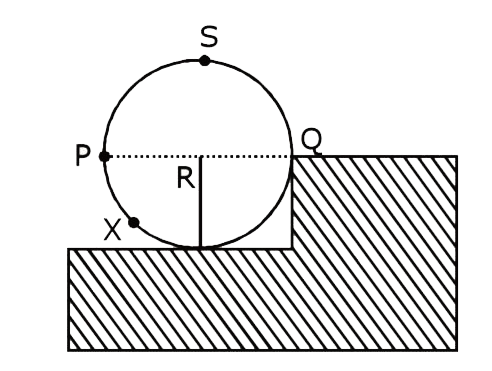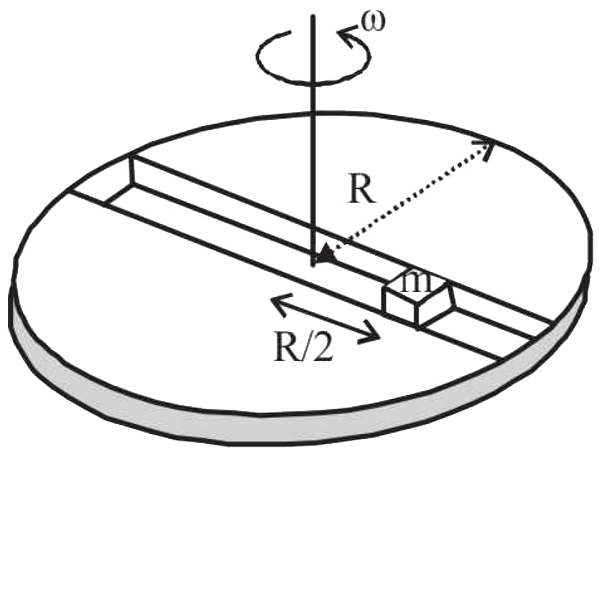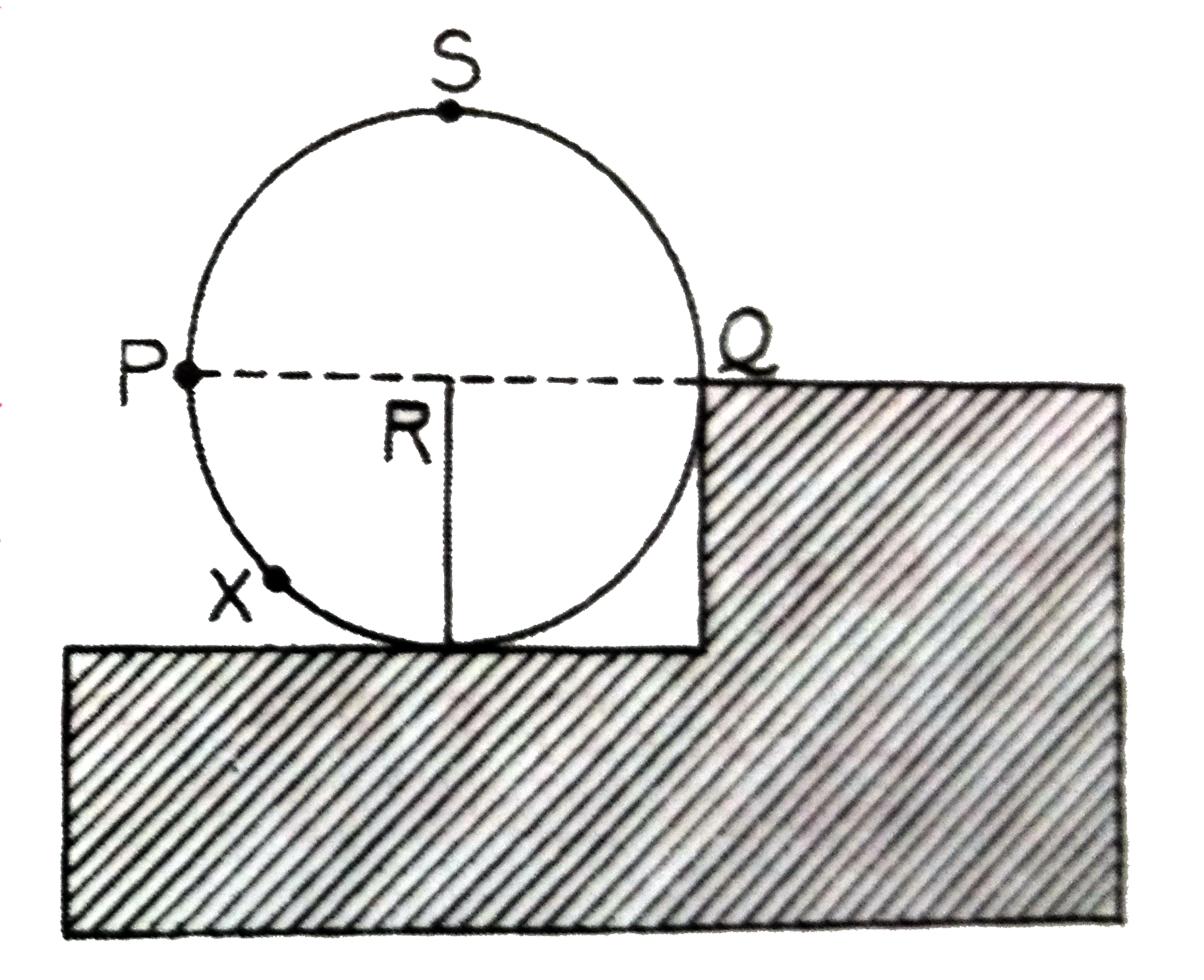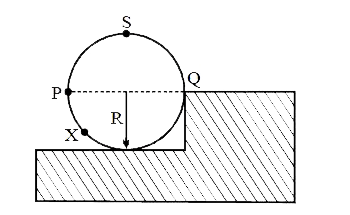A wheel of radius R and mass M is placed at the bottom of a fixed step of height R as shown in the figure. A constant force is continuously applied on the surface of the wheel so that it just clims the step without slipping. Consider the torque τ about an axis normal to the plane of the paper passing through the point Q. Which of the following options is/are correct?

If the force is applied at point P tangentially then τ decreases continuously as the wheel climbs
If the force is applied normal to the circumference at point ? then τis constant
If the force is applied normal to the circumference at point ? then τ_xDF0F_ is zero
If the force is applied tangentially at point ? then 1≠0 but the wheel never climbs the step
The correct Answer is:A, D
Step by step video & image solution for A wheel of radius R and mass M is placed at the bottom of a fixed step of height R as shown in the figure. A constant force is continuously applied on the surface of the wheel so that it just clims the step without slipping. Consider the torque tau about an axis normal to the plane of the paper passing through the point Q. Which of the following options is/are correct? by Physics experts to help you in doubts & scoring excellent marks in Class 12 exams.
Updated on:21/07/2023Topper's Solved these Questions
- JEE ADVANCEDBOOK - JEE ADVANCED PREVIOUS YEARCHAPTER - JEE ADVANCEDEXERCISE - Part I : PHYSICS (Section 3)Paragraph 2
2 Videos
- JEE ADVANCEDBOOK - JEE ADVANCED PREVIOUS YEARCHAPTER - JEE ADVANCEDEXERCISE - SECTION 1
6 Videos
- JEE ADVANCEDBOOK - JEE ADVANCED PREVIOUS YEARCHAPTER - JEE ADVANCEDEXERCISE - PART I : PHYSICS (SECTION 3)
2 Videos
- JEE (ADVANCE) 2020BOOK - JEE ADVANCED PREVIOUS YEARCHAPTER - JEE (ADVANCE) 2020EXERCISE - SECTION 3
6 Videos
- JEE ADVANCED 2020BOOK - JEE ADVANCED PREVIOUS YEARCHAPTER - JEE ADVANCED 2020EXERCISE - SECTION-3
6 Videos
Similar Questions
One twirls a circular ring (of mass and radius ) near the tip of one’s finger as shown in Figure 1. In the process the finger never loses contact with the inner rim of the ring. The finger traces out the surface of a cone, shown by the dotted line. The radius of the path traced out by the point where the ring and the finger is in contact is ?. The finger rotates with an angular velocity 20. The rotating ring rolls without slipping on the outside of a smaller circle described by the point where the ring and the finger is in contact (Figure 2). The coefficient of friction between the ring and the finger is μ and the acceleration due to gravity is g.

The minimum vlaue of ω0 below which the ring will drop down is
View SolutionThe potential energy of a particle of mass ? at a distance ? from a fixed point ? is given by V(r)=kr2/2, where ? is a positive constant of appropriate dimensions. This particle is moving in a circular orbit of radius ? about the point ?. If ? is the speed of the particle and ? is the magnitude of its angular momentum about ?, which of the following statements is (are) true?
View SolutionA frame of reference that is accelerated with respect to an inertial frame of reference is called a non-inertial frame of reference. A coordinate system fixed on a circular disc rotating about a fixed axis with a constant angular velocity ω is an example of non=inertial frame of reference. The relationship between the force →Frot experienced by a particle of mass m moving on the rotating disc and the force →F∈ experienced by the particle in an inertial frame of reference is
→Frot=→Fin+2m(→vrot×→ω)+m(→ω×→r)×→ω.
where →vrot is the velocity of the particle in the rotating frame of reference and →r is the position vector of the particle with respect to the centre of the disc.
Now consider a smooth slot along a diameter fo a disc of radius R rotating counter-clockwise with a constant angular speed ω about its vertical axis through its center. We assign a coordinate system with the origin at the center of the disc, the x-axis along the slot, the y-axis perpendicular to the slot and the z-axis along the rotation axis (→ω=ωˆk). A small block of mass m is gently placed in the slot at →r(R/2)ˆi at t=0 and is constrained to move only along the slot.

The distance r of the block at time is
View SolutionA spherical bubbles inside water has radius R . Take the pressuere in the bubbled and the water pressure to be pv. The bubble now gets compressed radially in an adiabatic manner so that its raduis becomes (R - a) . For a<<R the magnitude of the work done in the process is given by (4πpoRa2)X. where X is a a constant and y=Cp/Cv=41/30. The value of X is
View SolutionPut a unifrom meter scale horizontally on your extended index fingers with the left one at 0.0 cm and the right one at 90.00 cm when you attempt to move both the fingers slowly towards the center , initially only the left finger slips with respect to to the scale and the right finger does not . after some distance, the left finger stops and the right one starts slipping . Then the right finger stops at a distance XR from the center (50.00 cm ) of the scale and the left one starts slopping again . This happens because to the difference in the fiictional forces on the two fingers . it the coefficients of static and dynamic between the fingers and the scale are 0.4 and 0.32 respectively , the value of XR (in cm is ...........
View SolutionA constant horizontal force of 10 N is applied at the centre of a wheel of mass 10 kg and radius 0.30 m . The wheel rolls without slipping on the horizontal surface, and the acceleration of the centre of mass is 0.60 m//s^(2) . a. What are the magnitude and direction of the frictional force on the wheel? b. What is the rotational inertia of the wheel about an axis through its centre of mass and perpendicular to the plane of the wheel?
View SolutionA wheel of radius r and mass m stands in front of a step of height h . The least horizontal force which should be applied to the axle of the wheel to allow it to raise onto the step is
View SolutionThe drwing shows a bicycle wheel of radius r, resting against a small step whose height is h = r//5 . A clockwise torque increases, there comes a time when the wheel just begins to rise up and loses contact with the ground. Let this torque be T. What is the magniitude of the horizontal component of the acceleration of the centre of the wheel when a torque of 2T is applied? Assume that the wheel doesn't slip at the edge of the step when this torque is applied (ignore the mass of the spokes).
View SolutionA wheel of radius R=0.1m is rolling without slipping on a horizontal surface as shown in the firgure. Centre of the wheel moves with a constant speed √3m/s. The speed of the point P with respect to ground is

View SolutionA wheel ( to be considered as a ring ) of mass m and radius R rolls without sliding on a horizontal surface with constant velocity v. It encounters a step of height R/2 at which it ascends without sliding
View SolutionA wheel of radius 'R' is placed on ground and its contact point 'P'. If wheel starts rolling without slipped and completes half a revolution, find the displacement of point.
View SolutionThe minimum horizontal force applied to the centre of wheel of radius R and weight w to pull it over a step of height R//2
View Solutionएक त्रिज्या R एवं द्रव्यमान M का पहिया एक R ऊंचाई वाले द़ढ़ सोपान के तल पर रखा है (जैसे की चित्र में दिखाया गया है) । पहिये को सोपान पर चढ़ाने मात्र के लिए एक अचन बल पहिये के पृष्ठ पर सतत कार्यरत है। कागज के पृष्ठ से अभिलम्ब दिशा में बिंदु Q से जाने वाली अक्ष के सापेक्ष बल आघूर्ण τ मानिये। निम्न में से कौन से प्रकथन सही है?

View SolutionA wheel of radius R and mass M is placed at the bottom of a fixed step of height R as shown in the figure. A constant force is continuously applied on the surface of the wheel so that it just climbs the step without slipping. Consider the torque tau about an axis normal to the plane of the paper passing through the point Q. Which of the following options is/are correct?
View Solutionएक त्रिज्या R एवं द्रव्यमान M का पहिया (wheel) एक Rऊँचाई वाले दृढ़ सोपान (step) के तल पर रखा है। (जैसे चित्र में दिखाया गया है) पहिये को सोपान पर चढ़ाने मात्र के लिये एक अचर बल पहिये के पृष्ठ पर सतत (continuous constant force) कार्यरत है। कागज के पृष्ठ से अभिलंब दिशा में (perpendicular to the plane of the paper) बिन्दु Q से जाने वाली अक्ष के सापेक्ष बलआघूर्ण τ मानिये। निम्न में से कौन (सा) से प्रकथन सही है/हैं?

View SolutionA wheel ( to be considered as a ring ) of mass m and radius R rolls without sliding on a horizontal surface with constant velocity v. It encounters a step of height R/2 at which it ascends without sliding
View Solution
